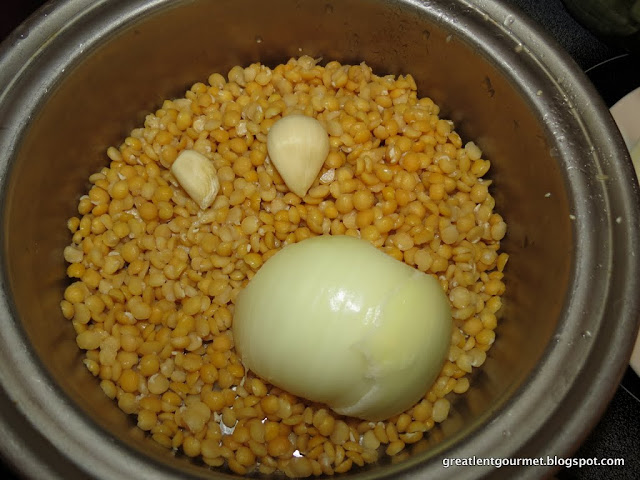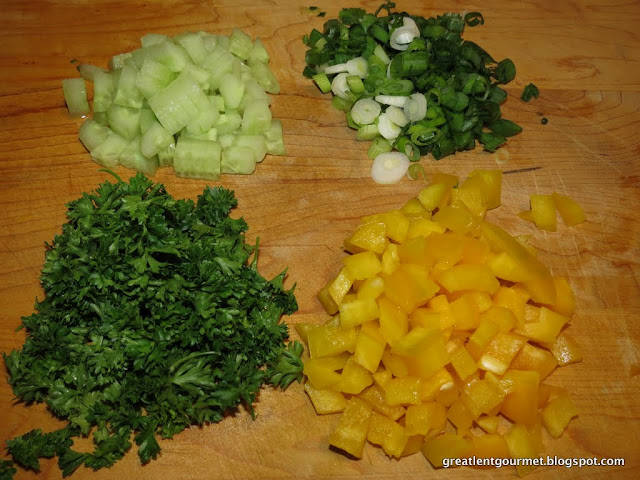Fava, in Greek cuisine, is a very versatile ingredient. For someone not familiar with the term "fava" in Greek, it does not refer to the common broad bean known as the fava bean. To many people of Greek ancestrtry, the fava bean (Vicia faba) is, in fact, poisonous. The dish we are preparing today, fortunately, is a very safe dish and a very tasty one at that! When Greeks refer to "fava" as food, they are referring to yellow split peas; the common greek term for the actual fava bean is "koukia" (κουκιά).
Many cultures use split peas as a staple food in their diets. For example, here in Canada, various regions have their version of yellow split pea soup, which we know as a typical part of many family dinners (in Quebec it is very popular, particularly with cubed smoked ham or bacon). In the past, British people boiled yellow split peas to make a thick soup or stew, often referred to as porridge, but it carried a stigma of being just for the poor people to eat. That is no longer true, we believe. Many people (all over the world) have found that beans and legumes enhance their diet in a healthy, nutrient rich, and inexpensive way.
 |
| Raw, uncooked fava (yellow split peas) |
Yellow split peas are rather inexpensive and can be used to feed many people. It is always nice to find a cheap way to feed so many! In fact, we recently paid $1.29 (Canadian) for 750 grams (26 oz).
Well, we went looking for the right recipe -- one that was traditional and appropriate for Great Lent. We found this recipe in our cookbook Food From Many Greek Kitchens by Tessa Kiros. She has an interesting story of her own about why she assembled this book and about her own family background (her parents are Greek Cypriot (father) and Finish (mother). Some of the recipes sounded like what my Yiayia made, and others sounded a little less familiar. This well written and beautifully illustrated cookbook is separated into chapters with titles that we liked (e.g. Traditional Foods, Fasting Foods, Easter Foods, Ladera and Salads...).
In the "Fasting Foods" chapter, we found the explanation on how to make fava. And, it seemed like it would be mild, but tasty. So, for this recipe to make 4 cups, you will need:
18 oz fava (about 500 g)
1 small onion, peeled
2 cloves garlic, peeled
1 to 1 1/2 teaspoons salt
To garnish, use olive oil, sliced red onions, and/or capers
Since the olive oil is just a garnish, omitting it can be ideal for a very strict fast! Today, we completely omitted oil from this recipe. Here is how we made Fava:
First, rinse the fava. Rinse well because there is a film on the peas that will turn the water very murky.
 |
| Rinse the fava very well. |
 |
| If you don't rinse the fava well enough, you will see this murky, cloudy water. If so, rinse again until the water is clear. |
 |
| Now the water is clear. |
 |
| The foam from the boiling fava. |
Return the fava to the pot. Drop in the onion and the garlic. Leave the onion and garlic whole, because if it is cut, it will fall apart and you will have difficulty retrieving it in a later step. (We had only large onions, so ours was cut in half. But, it was difficult to pull out the individual layers of onion.)
Now, add 4 cups of HOT water and bring the mix back to a boil. Partially cover the pot and let it boil for about 30 minutes. Then, take the lid off the pot, turn down the heat and simmer the peas until most of the water is absorbed. You will see that the split peas start turning break down and fall apart, and that is what you want!
Then, using a fork or spoon, pull out the onion and the garlic. You will likely have some of the peas stuck to the garlic, but that's okay; it's not that much to lose. If you try to pull the peas off of the cooked garlic or the onion, you will likely smash the garlic or the onion will end up with that puree in your peas. This can be too strong of a flavour, so try to avoid that.
Now, smash the fava to the consistency that you prefer. You can use a hand blender, but a fork was easy since the peas were so soft and creamy already. You can make it as creamy or as chunky as you prefer, and with a fork, you have more control over the texture.
Lastly, add a pinch or two of salt. The amount you will add will be based on your personal preference. We found that the a bit of salt was necessary, otherwise the final product was too bland.
Mix the salt in well, and continue to smash the peas to the ultimate texture. We chose to make ours more chunky than smooth. Let the fava cool a bit before putting it in the serving dish. You can serve this warm or cold.
And, garnish it as you like. We chose to use large capers. The salty caper was a nice complement to the mildly flavoured fava.
Once we served the fava to our guests at dinner, we found that a little squeeze of a lemon produced a beautiful flavour. It's something that we jokingly say in our household about fixing many flavour issues in Greek cuisine -- just add lemon! One taster said that she noticed the garlic in this dish and that it was, "... better than any hummus I have eaten." This dish could easily be a substitute for hummus. It even has the same colour as hummus. Another taster has made this in a creamier version and used it like a sandwich spread with lettuce and tomato, but also enjoyed that we left ours more roughly mashed. And, one other taster claimed, "It is not a strong flavour, but mildly smooth and very pleasant." That said it all for us -- smooth and pleasant!
We hope that you enjoy the fava as much as we did. This is one recipe from this book that we will continue to make. If you have other ways to make Greek fava, we would love to hear your methods or ideas. Until then, καλή όρεξη!
Let us be satisfied simply with what sustains our present life, not with what pampers it. Let us pray to God for this as we have been taught, so that we may keep our souls unenslaved and absolutely free from domination by any of the visible things loved for the sake of the body. Let us show that we eat for the sake of living, and not be guilty of living for the sake of eating. The first is a sign of intelligence, the second proof of its absence.
- St. Maximus the Confessor
- St. Maximus the Confessor










































